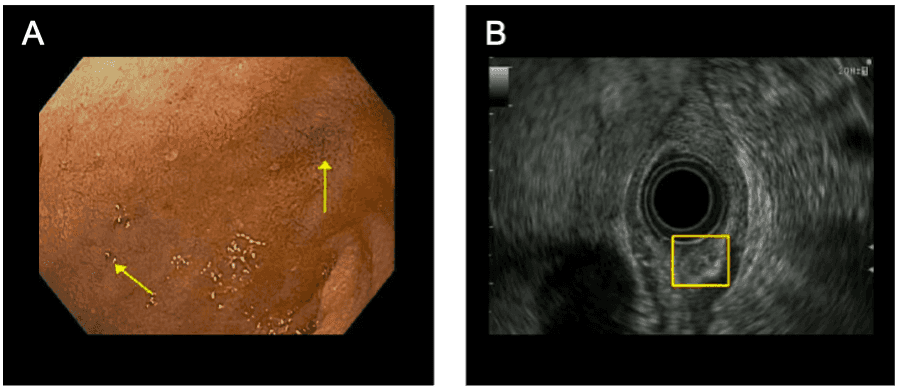Open Antrectomy and Duodenal Resection for Neuroendocrine Tumor
Abstract
This video describes the surgical technique for an open duodenal resection and antrectomy, which was performed for a neuroendocrine tumor of the duodenal bulb. In this procedure, we start with an upper midline laparotomy and proceed with mobilization of the distal stomach, duodenum, and head of the pancreas. To mobilize, we Kocherize the duodenum, then ligate that right gastric artery and dissect the gastrohepatic ligament, followed by ligation of the right gastroepiploic vessels and take down the gastrocolic ligament exposing the lesser sac. Once the structures are adequately mobilized, we dissect the first portion of the duodenum off of the head of the pancreas and transect it with a TA stapler. The antrectomy is performed next, removing the specimen. For the reconstruction, we perform a retrocolic end-to-side hand-sewn gastrojejunostomy. This technique can be used for multiple indications, including peptic ulcer disease and other mass lesions of the antrum, pylorus, or duodenal bulb.
Keywords
Kocher maneuver; antrectomy; duodenectomy; neuroendocrine tumor; gastrojejunostomy.
Case Overview
Background
Neuroendocrine tumors (NETs) arise from the secretory cells of the diffuse neuroendocrine system, which includes the alimentary tract and pancreas. NETs are the second most common digestive cancer after colorectal cancer. Approximately 70% of NETs occur in the small intestine or colon, 12% in the pancreas, and 5% in the appendix.1 NETs are heterogenous in character, the majority have indolent growth, and a subset will secrete hormones or bioactive amines resulting in functional disorders.2 Carcinoid tumors are a type of NET arising from enterochromaffin cells that produce serotonin. Other types of NETs can produce insulin, glucagon, somatostatin, gastrin, or vasoactive intestinal peptide (VIP). NETs are diagnosed using a combination of clinical presentation, biochemical markers, pathology, and imaging.3 The aggressiveness of NETs is determined primarily by tumor grade, which is variable based on location.4 The incidence has increased over the last four decades, but this is thought to be partly attributed to increased diagnostic imaging. Twenty-seven percent of patients will present with metastatic disease at time of diagnosis.5
Given the heterogeneity of NETs, which exhibit variability in biologic aggressiveness and secretion of bioactive chemicals, managing these tumors often requires a personalized approach. Surgical resection remains the sole curative therapy for NETs in general. Endoscopic resection may also be considered for duodenal lesions smaller than one centimeter in diameter. However, this procedure is technically challenging due to the anatomical characteristics of the duodenum. Additionally, it carries a risk of perforation and a positive vertical margin due to infiltration into the submucosa.6,11
In this video, we perform a duodenal resection with antrectomy for a duodenal NET in a 48-year-old woman. The mass had benign features on clinical workup; however, due to an increase in size of the lesion on surveillance endoscopy, the decision was made to proceed with surgical resection with curative intent.
Focused History of the Patient
The patient is a 48-year old woman with a history of gastroesophageal reflux disease who was found to have a tumor in her duodenal bulb on esophagogastroduodenoscopy. An endoscopic ultrasound was performed to further characterize the lesion, which was found to be 5 mm in maximal dimension and appeared submucosal. The lesion was tattooed, and the patient was followed with routine endoscopy to monitor the mass. Two years later, the mass had grown modestly, and she was referred to the surgical clinic for resection. Her other medical history is notable for obesity, diabetes mellitus, and hypertension. She has no prior abdominal surgical history. Her last colonoscopy was three years ago and was normal. She has an American Society of Anesthesiologist score (ASA) of 2 and her body mass index (BMI) is 31.
Physical Exam
The patient had an unremarkable physical exam. In the office, she presented in no apparent distress with normal vitals. She had a normal habitus. Her abdominal exam was unremarkable with no evidence of prior surgical scars, hernias, or tenderness to palpation. Her abdomen was soft and nondistended.
Imaging
Relevant Imaging can be seen in Figure 1.

Figure 1. Relevant Imaging. (A) Endoscopic image of duodenum. Yellow arrows point to blue ink tattoo from prior endoscopic marking of the mass. The lesion is small and not visible on conventional endoscopy. (B) Endoscopic ultrasound image of the neuroendocrine tumor, which is captured within the yellow box. The lesion is subepithelial on ultrasound.
Natural History
The clinical course of NETs is highly variable. Low grade, well differentiated lesions typically have an indolent course with low metastatic potential, whereas high grade NETs rapidly progress with distant spread. Survival is also associated with tumor location, and pancreatic NETs with high grade features have dismal 5-year survival rates of less than 10%.7 The sequence of genetic and epigenetic alterations that drive NET development is variable when comparing low versus high grade lesions, but also when comparing origin of cell type, indicating that the molecular pathology and subsequent clinic course is heterogeneous among NETs.
Options for Treatment
The only potential curative therapy for NETs is surgical resection of the tumor. Nonetheless, the surgeon should discuss the risks and benefits of an operation with the patient. In certain instances, an attempt with endoscopic resection is reasonable for small lesions with low-risk features. For metastatic disease, surgery may be indicated if the entirety of disease is extirpatable, or in situations where debulking might significantly improve quality of life for hormone secreting masses. However, in most cases of metastatic disease, cytotoxic chemotherapy and anti-hormonal therapy are the mainstays of treatment.
Rationale for Treatment
The rationale for surgical resection for non-metastatic NET is complete disease removal with curative intent.
Special Considerations
There are several caveats to surgical resection for NETs. First, surveillance may be considered for duodenal NETs that are less than 1 cm in diameter with low-risk features, endoscopic resection is acceptable.8 Second, for high grade lesions, the role of surgery is less clear due to the increased risk of distant spread and poor prognosis. Third, non-curative surgical debulking may be considered in certain cases of metastatic disease to improve quality of life for hormone-secreting tumors.
Discussion
As we have shown in this video, the main procedural steps for this operation are as follows: (1) upper midline laparotomy, take down falciform ligament, explore peritoneal cavity; (2) Kocherization of the duodenum; (3) ligate the right gastric artery, takedown of the gastrohepatic ligament; (4) ligate the right gastroepiploic artery, takedown of the gastrocolic ligament, and entry into the lesser sac; (5) mobilization of the first portion of the duodenum off of the head of the pancreas; (6) transect the duodenum with a TA stapler; (7) transect the antrum of the stomach with an ILA stapler; and (8) perform a Billroth II reconstruction with a retrocolic end-to-side Hoffmeister gastrojejunostomy. This approach allows for an extensive mobilization of the duodenum and distal stomach to ensure negative resection margins.
There are two options for gastrojejunostomy: antecolic and retrocolic. In the retrocolic approach, the jejunum is brought through a mesenteric window of the transverse colon, which results in a shorter afferent loop and reduced risk of afferent loop syndrome. On the other hand, the antecolic approach is considered technically easier, and is preferred in cases of malignancies.12
Duodenal NETs are rare, representing less than 5% of primary duodenal neoplasms and less than 10% of all NETs.9 The majority of duodenal NETs are non-functional, less than 2 cm in diameter, and incidentally discovered in otherwise asymptomatic patients.8 These tumors typically present in the deep mucosa and have a submucosal appearance on endoscopy. The standard treatment for duodenal NETs is surgical resection. However, for lesions that are low grade, have small size, and are non-functional, endoscopic resection can be considered.10 Observation for low-grade, small lesions is not recommended due to risk of lymph node metastasis.
The type of surgical resection depends on the location and size of the lesion within the duodenum. Ampullary tumors tend to have worse prognosis and often require a pancreaticoduodenectomy for negative margins and adequate nodal yield. Duodenal NETs on the anti-mesenteric border of the bowel can sometimes be resected in a wedged fashion if sufficiently small and with low-risk features. For other cases, a segmental duodenal resection is necessary. In the case of our patient, we elected to perform a D1 resection with an antrectomy. We chose this procedure because the lesion was not localizable intraoperatively and therefore was not amenable to a wedge resection.
Patient Outcome Statistics from Procedure
- Operative time: 68 minutes
- Estimated blood loss: 50 mL
- Fluids: 1700 mL crystalloid
- Length of Stay: discharged from hospital to home without services on postoperative day 4
- Morbidity: no complications
- Final pathology: neuroendocrine tumor, grade 1, stains positive for gastrin
Equipment
- 10-blade scalpel
- Electrocautery
- DeBakey forceps
- Abdominal wall handheld retractor
- Schnidt clamp
- 3-0 and 2-0 silk ties for ligation of mesentery
- Metzenbaum scissors
- ILA stapler
- TA stapler
- 3-0 Vicryl and 3-0 silk for gastrojejunostomy
- 1-0 Prolene suture for fascial closure
- Skin stapler
Disclosures
Nothing to disclose.
Statement of Consent
The patient referred to in this video article has given their informed consent to be filmed and is aware that information and images will be published online.
Acknowledgments
We would like to thank Theresa Kim, MD for assisting in this operation.
Citations
- Frilling A, Akerstrom G, Falconi M, et al. Neuroendocrine tumor disease: an evolving landscape. Endocr Relat Cancer. 2012;19:R163-85. doi:10.1530/ERC-12-0024.
- Cives M, Strosberg JR. Gastroenteropancreatic neuroendocrine tumors. CA Cancer J Clin. 2018;68:471-87. doi:10.3322/caac.21493.
- Oberg K, Couvelard A, Delle Fave G, et al, Antibes Consensus Conference p. ENETS Consensus Guidelines for Standard of Care in Neuroendocrine Tumours: Biochemical Markers. Neuroendocrinology. 2017;105:201-11. https://doi.org/10.1159/000461583.
- Kloppel G, La Rosa S. Ki67 labeling index: assessment and prognostic role in gastroenteropancreatic neuroendocrine neoplasms. Virchows Arch. 2018;472:341-9. doi:10.1007/s00428-017-2258-0.
- Dasari A, Shen C, Halperin D, et al. Trends in the incidence, prevalence, and survival outcomes in patients with neuroendocrine tumors in the United States. JAMA Oncol. 2017;3:1335-42. doi:10.1001/jamaoncol.2017.0589.
- Partelli S, Bartsch DK, Capdevila J, et al, Antibes Consensus Conference p. ENETS Consensus Guidelines for Standard of Care in Neuroendocrine Tumours: Surgery for Small Intestinal and Pancreatic Neuroendocrine Tumours. Neuroendocrinology. 2017;105:255-65. doi:10.1159/000464292.
- Strosberg JR, Cheema A, Weber J, Han G, Coppola D, Kvols LK. Prognostic validity of a novel American Joint Committee on Cancer Staging Classification for pancreatic neuroendocrine tumors. J Clin Oncol. 2011;29:3044-9. doi:10.1200/JCO.2011.35.1817.
- Sato Y, Hashimoto S, Mizuno K, Takeuchi M, Terai S. Management of gastric and duodenal neuroendocrine tumors. World J Gastroenterol 2016;22:6817-28. doi:10.3748/wjg.v22.i30.6817.
- Yao JC, Hassan M, Phan A, et al. One hundred years after "carcinoid": epidemiology of and prognostic factors for neuroendocrine tumors in 35,825 cases in the United States. J Clin Oncol. 2008;26:3063-72. doi:10.1200/JCO.2007.15.4377.
- Kulke MH, Shah MH, Benson AB III, et al; National comprehensive cancer network. Neuroendocrine tumors, version 1.2015. J Natl Compr Canc Netw. 2015 Jan;13(1):78-108. doi:10.6004/jnccn.2015.0011.
- Furukawa K, Nakamura M, Kawashima H, Fujishiro M. Endoscopic resection of a duodenal neuroendocrine tumor. Rev Esp Enferm Dig. 2022;114(5):291-292. doi:10.17235/reed.2021.8232/2021.
- Miyazaki Y, Oda T, Shimomura O, et al. Retrocolic gastrojejunostomy after pancreaticoduodenectomy: a satisfactory delayed gastric-emptying rate. Pancreas. 2019;48(4):579-584. doi:10.1097/MPA.0000000000001295.

